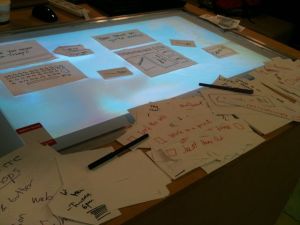I wrote an article last year with my colleague John Venable on “Participatory Action Design Research” (PADR), which just got published here. We describe PADR as a method to better involve users in the design process of interactive technologies.
In Urban Informatics, we primarily design digital technologies and applications for members of the public in the context of urban environments and urban public places. As an urban informatics designer, how do you embrace members of the public in the design process? Traditionally, many user studies are conducted in laboratory settings, which lacks the context and messiness of everyday life settings of which the design artefact will be part of.
PADR suggests that the design and evaluation stage should not only embrace users in the design process, but also do this in the context and environment where the technology will later be installed and used. While in our paper John and I talk about PADR theoretically, i.e. combining the principles of Action Research and Design Research methodology, we don’t have any empirical data of how good this method works in practice.


Today, I made quite a surprising experience in regards to PADR. I worked with my colleague Alessandro Soro on a user interface concept for a multitouch table that we want to install as part of a project at The Edge.
As Lab 2 was booked for a workshop, we rolled the multitouch table to one of the window bays in the main visitor area at The Edge and started our design and paper prototyping work there. We didn’t really intend to involve any users at that stage, but rather just play around with some initial ideas what features to include and how the user interface might look like.
To my surprise, random passersby would stop and ask us what we are working on and what that big table is all about. We would explain what the project idea is and invite them to play with the paper prototype. Of course, I took this as a chance to take notes about how they responded to the paper prototype as well as their comments and further ideas.
We didn’t do any advertising or invites for a user study, but just worked from the window bay as ordinary Edge visitors. We worked from 1:30pm till 7:30pm (6hrs) and were approached 3 times by random individuals. With two of them we ended up walking through the paper prototype, and they spend easily half an hour each hanging out with us, providing feedback and suggesting own ideas.
They felt quite passionate about the idea of a check-in system and the possibilities with the multitouch table. Both users enthusiastically agreed to share their email address and be contacted at a later stage for a more formal user study with a later prototype of the user interface. And one of them even came back an hour later to tell us two more ideas he had thought of for the multitouchtable.
I realised how much easier and more fruitful it is to do participatory design with such intrinsically motivated people than with randomly selected users and stakeholders. I will make sure to work more often at the visitor area during my future design work at The Edge to facilitate such serendipitous encounters with interested users.
Maybe next time I will also put up a sign, e.g. saying “I’m designing an interface for an interactive multitouch table. Join me!”, and work with whoever is willing to join. This approach might not serve the biggest quantity of participants, but at least this way I can be sure that people who stop and voluntarily join are intrinsically motivated. Overall more quality feedback and ideas, plus it saves time and money on recruiting official “test users” whom you sometimes even need to pay or provide other compensations for their time.










Very interesting Mark! As you say, theoretical design of a research methodology is one thing; enacting it with real users is another. This approach to working with the public sounds great. I’m doing work with NfP organisations and plan to use PADR, but may need to focus more on recruiting than just putting up a sign! Still, this is good food for thought …
LikeLike